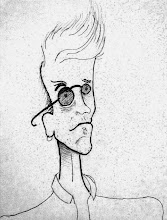The white was supposed to be calming. Apparently, there was something meditative about the idea of a void, perhaps something therapeutical. But if you build a room full of emptiness, how would you treat the claustrophobic, the agorophobic? Certainly, these issues would have remained unaddressed to the Eastern philosophers whose 'clear'-thinking had inspired such a local infinity.
The good Dr. Roeper pressed his hands to his eyes, massaging over the glasses. The isolation rooms always gave him a headache. It wasn't the brilliant and unadorned vision of the whitest purity that hurt his eyes, but more the thoughts imprinted on it. Here was a room for the making of mental graffiti; a clear surface on which to impress the every thought. This was Freud's free association raping the notion of interior design. Still, it had its merits.
The Rorschach blots were in disuse, vague and superficial attempts to perceive perception. The Intelligence tests were invariably driven to extreme distributions, giving no clue as to the purposefulness or the simple lack of imagination behind the scores. The Personality tests arbitrarily grouped the like-traits without individuating.
No, it was here that the White Room was the diagnostic panacea. At each corner of the cuboidal chamber, a hair-thin camera watched. At periodic intervals of space, a microphone had been placed inconspicuously. As Roeper's eyes and ears perceived nothing but the literal mental white noise from their surroundings, a myriad of recordings perceived his every waking moment-- if not his every waking thought. The panopticon was invisible and omniscient.
It had been the downfall of the softer elements of psychology, that puerile and fanciful notion of reading thoughts. It was with deserved triumph that the focus on observable behaviours and modes of thought prevailed. What better a place to do this than in this canvas of the mind, this White Room?
Roeper walked across the padded floor, ten feet from wall to wall to wall to wall. The light, masterfully scattered, gave no hint as to the source, evenly distributed along the toughened membrane of the room. Reassuring padding, uniformly present, was a necessary distraction for many of the more physically spastic patients. Microscopic pores fed fresh oxygen, and cycled the carbon dioxide out. Pressure-sensitive instruments recorded the rate of respiration, saturation of oxygen, and analyzed the patient's heart rate.
It had been twenty minutes since Roeper had entered the room, but already he was entirely uncertain as to the existance of anything outside himself. The suffocating fear of being lost had been quickly replaced with a sense of perfect calm. Still, the headache persisted.
Three hours later, and Dr. Roeper had became dully aware of minute vibrations in the room. Regrettably, the orderlies outside the room had no access, no means of unlocking the room until the treatment time prescribed by the administrator expired. Dr. Roeper had, of course, discarded his administrator nametag before entering the room. He began a conversation with his grandaughter, who was remarkably chatty for a stillborn.
Seventeen hours in, and Roeper was marching wearily from one end of the room to the other, buffeted by the crowd that surrounded him. The cameras observed this only as a tired old man swaying mechanically to a waning pulse. The ex-administrator's voice described in perfect detail the action of opioid receptors in the lateral thalamus while he gestured with his hands. The porous walls of the room had absorbed his attempts to draw a molecular structure with the blood of his torn hands and nails, but not before the cameras had recorded every last bond and angle.
It was after thirty-five hours that the room lock reached its expiry time, and the orderlies rushed in to find a pale and motionless Dr. Roeper. The man's frail figure had been coated in a plume of crimson, eminating from uncountable pores. On the floor, neither spot nor drop could be discerned. Medical personnel, of whom there were plenty, had watched the doctor's vital signs plummet well into the stages of irreversible shock. They went through the obvious motions of resuscitation, but to no avail.
Roeper's eyes, piercing and blue, were shrunken in their sockets. They tracked sluggishly, settling onto the unending ceiling. His irises seemed colourless and dead. The man's eyelids crinkled, and an unsettling smile split his face at an impossible angle.
"Oh, but I know." He chortled, his previously calm and collected voice now a ratcheting and spewing bark, "Now I know."
He began to laugh. It was a coarse and brutal guffaw that escalated into heady cackle, only to be cut short and trail into echo. The room's filamentous cameras watched detachedly as the good Dr. Roeper, inventor of the White Room, passed into the void forever.
Sunday, September 27, 2009
Subscribe to:
Post Comments (Atom)

No comments:
Post a Comment